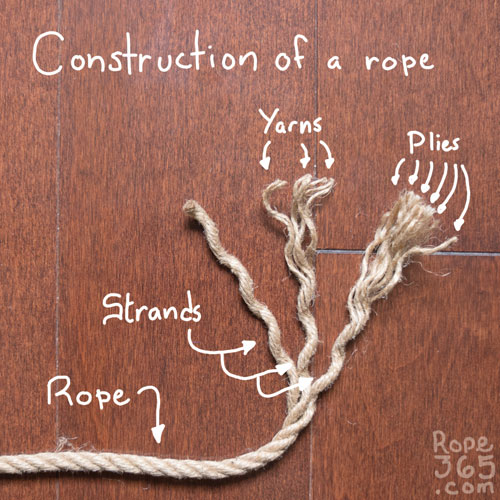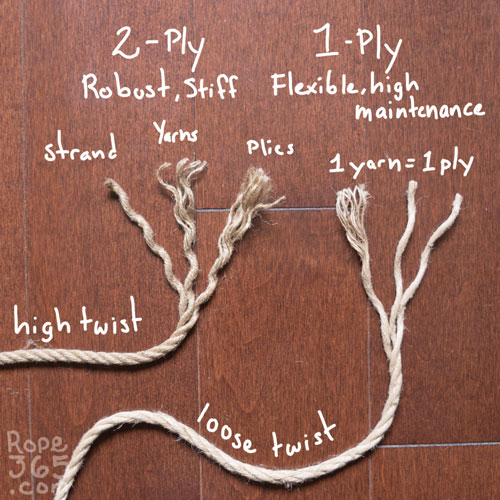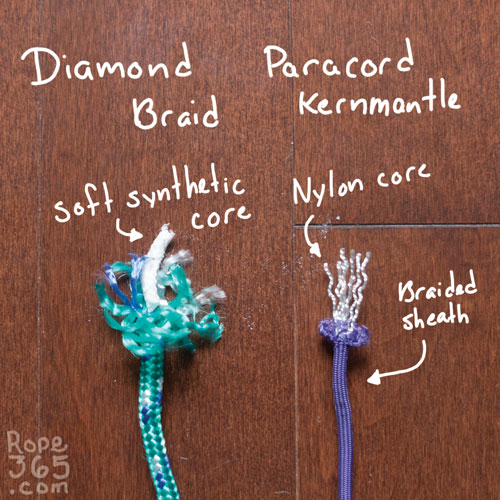Day 46: Construction
Rope constructed with different techniques will feel completely different, even if they are made from the same material. Most ropes are made from smaller cords that are assembled to make a thicker rope, the more twine, the bigger the rope. These can be twisted or braided in various ways, to make rope with different properties.
Twisted Rope
Spinning twine into a cord is the most common type of rope. When you take a twisted rope apart, it will first unravel in strands. When you untwist a stand it will divide in yarn. And if the rope is 2-3 plies, then you will be able to divide it again in plies. Most twisted ropes are made from 3 strands as it is a very stable structure. On occasion we can see smaller rope made of 2 stands, or larger ropes made of 4+ strands.
Twisted ropes are the most ancient type of rope as they can be spun without a machine. The first evidence of rope is a 3-ply cord from 40, 000 years ago. Because of its long history, there are lots of techniques like splices or specialized stopper knots that will only work with twisted ropes.
When shopping for rope, you might see a mention that rope is single-ply (1-ply) or double-ply (2-ply). This refers to the number of ply per yarn. Generally, a rope with more ply will be more robust, but also stiffer. Single-ply rope will generally be more flexible but will also require more maintenance and have a higher tendency to highstrand. But this is not always true. Other aspects of the construction can have a bigger impact on the rope characteristics. A tighter rope twist will make the rope more rigid with a more coarse texture while a lower twist will feel smoother and flexible.
Braided Rope
Rope twine can also be braided to create a rope, these are usually machine-made as these are made with complex structures. Some rope will be completely made of the braid, different technique giving rope with more or less stretch, the looser the tension, the more flexible the rope. Two ropes that look identical from the outside can be very different inside. The type of braid will influence its characteristics, solid braids will be generally more flexible than other types of braids. Then again, other factors like the tightness of the braid will also influence these characteristics.
Rope Core
Some rope will have a core in the middle. Sometimes the core will be rope, and it can be from the same material or a completely different one. It is not rare to see rope with a plastic core as well. Rope with soft cores tend to be less stable as the inside may deform independently from the outside.
Kernmantle ropes are interesting as they are made from very strong ropes on the inside for high tensile strength with a braided protective sheath on the outside for durability. This is the construction for most climbing rope, they generally end up being too stiff for bondage but there are exceptions. Paracord in particular, with its small diameter, is flexible enough for bondage and surprisingly strong and durable.
Twisted rope can have a core too. Three stranded ropes don’t need a core, but twisted rope with more strands may require one. It is also not uncommon to have a core in the middle of a strand. This allows the rope to have a looser twist while maintaining its strength. Many ropes from some of the famous Japanese brands have this kind of core. It is difficult but possible to see the core by untwisting a strand. To know for sure if your twisted rope has a core, cut a short length and take it apart. If you have a core, you should have plies that are shorter than the others.
Practice Time!
Gather samples from different types of ropes and compare them. Take notes of the characteristic before taking them apart to analyze their construction.
Exploration ideas
- Before taking the ropes apart
- How does the rope feel on the skin, pressing, dragging?
- How well does it hold knots and frictions?
- After taking the ropes apart
- When you cut the rope, does it unravel or does it stay together?
- Can you remove the core of the rope and keep the sheat intact?
- Count how many strands, yarn and plies are present in each rope
- Are all the plies of a rope the same length?
- Compare the length of plies of two different rope of the same length
- Are there different types of material in a single rope?
Inspirations and Resources
- Rope on Wikipedia
- Kernmantle rope on Wikipedia
- The jute story by Amatsunawa (check the other pages as well for more on rope construction)
- Rope Tidbits – about cores by MoonlightShadow
- Comparing the number of ply, picture by MoonlightShadow
- Core rope inside a strand, picture by MoonlightShadow
- Comparing different kind of twisted rope, picture by MoonlightShadow
- Core in a 4 stranded twisted rope, picture by MoonlightShadow
- Comparing 1-ply vs 2-ply, picture by MisterMarathon
- A surprise inside the rope, picture by Thorn168
Credit: R/P: EbiMcKnotty
Or return to The Rope for more options.





Leave a Reply